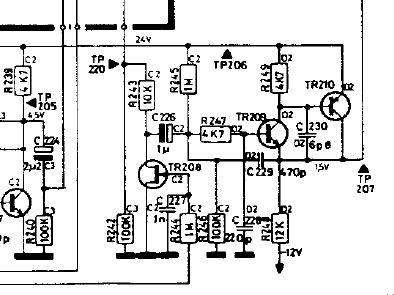Home › Forums › Product Discussion & Questions › BeoMaster › Beomaster 4400 – Sudden drop in sound?
- This topic has 49 replies, 5 voices, and was last updated 3 years, 1 month ago by

-
AuthorPosts
-
30 October 2022 at 05:04 #40279
notwist
BRONZE MemberHi all,
I have serviced this Beomaster and changed all old caps and tantalums two years ago. Now the machine has developed an odd problem.
When I power it on, no issue. It plays well and the sound is nice. But after some time the sound output will slowly drop to almost nothing. Very faint (but output still responds to volume control). It happens on both channels.
If I power down the machine and let it ‘cool’ for some time and power it on then the sound is back. But it will also die down very quickly. When I let it cool for a night it will play well for some 20 minutes and then the sound will drop again.
I am wondering what is the most common cause of this issue that affects both channels.
Many thanks for your thoughts,
Bert
30 October 2022 at 17:08 #40280notwist
BRONZE MemberHmmm, opened it up and it seems I did not change the main filter caps. But they test allright on my ESR meter. Also I can’t see them failing at the same time with the same issue.
Bert
30 October 2022 at 17:28 #40281 BRONZE Member
BRONZE MemberOdd.
Mine still runs on its original main caps too.
No hum anyway?I’d suspect a switch problem.
30 October 2022 at 17:41 #40282Glitch
BRONZE MemberHave you checked the thermal compound and mica insulators?
Sometimes, the thermal compound is fine after decades, other times it has dried out and shouldn’t be trusted.
Mica insulators can split between layers. These will look like there are air bubbles in the mica. Mica is a good thermal conductor, air is a good thermal insulator.
Disassembling, inspecting and replacing the thermal compound with modern, higher performance compound doesn’t take that much time. Even if it wasn’t needed, it can provide peace of mind.
Addition: The above comments are primarily targeted to the power supply components. These might affect both channels simultaneously. Also, if you have a FLIR camera, it is really useful for debugging potential thermal issues.
Glitch
30 October 2022 at 18:10 #40283Dillen
ModeratorCheck for cracked solder joints, particularly where connectors and the piggy-back boards are soldered in.
Does it run warm on the cooling fins? If so check the idle current settings.Martin
31 October 2022 at 07:38 #40284notwist
BRONZE MemberHi all,
- When I serviced the machine all output transistors were replenished with new washers and thermal compound
- There is no hum at all and the filter caps register as fine (outside of circuit)
- Sorry, no FLIR camera but nothing is getting really hot on the board aside from the transistor with the giant ‘star’ heatsink (which I would expect to get hot). But it doesn’t seem to be failing and a failure here would be apocalypse on the power supply
- There is one (1) component which I think is an old thermistor. It is in the middle of the heatsink. On inspection I saw that it’s very long legs were touching. That is not good. But I don’t know how to test the bugger.
I will indeed check the soldering again. I don’t see any cracked solder but i’ve experienced tired soldering on almost all B&O machines. Problem is that this is very hard to see. Doing a complete reflow of the main board is a total pain to say the least.
Bert
31 October 2022 at 08:51 #40285hcraig244
SILVER MemberBert
You dont say if the falling volume is occurring on all inputs i.e. FM tuner/phono/tape ?
Craig
31 October 2022 at 14:12 #40286hcraig244
SILVER MemberAnd incidentally one way of testing the thermistor is to blow a hairdryer over it and the fault relay should activate and shut the amp down.
Craig
31 October 2022 at 14:37 #40287Glitch
BRONZE MemberIs the thermistor R40? If so, the service manual calls it out as “50 0hm 30% PTC”. You can test it by removing it from the circuit, hooking it to an ohm meter and observe the resistance as you heat it up with something like a hair dryer.
I would also make notes of all of the voltages from the power supply and see how they change with time and temperature. From the schematic, it appears that many of the voltages are referenced from the +15v supply. If this dropped down, many of the other signals would follow.
Glitch
31 October 2022 at 15:04 #40288hcraig244
SILVER MemberOne way of determining if the 15v rail is falling off is to monitor the power ON lamp as this is fed from that supply.
Craig
31 October 2022 at 16:01 #40289notwist
BRONZE MemberHi all,
good leads, today I had some spare time to reflow the major connection points. I should have done this before because of the known issues with weak solder (not brittle or broken) joints on these machines.
I’ve got nothing connected to the machine at the moment so I can only describe the issue from the FM tuner. Please let me find some DIN to RCA cables and check the issue with another input.
I will check the voltages this evening, should have the time.
Will also desolder the thermistor, if that is broken it might explain the issue as well. Then again, the heatsinks are not even lukewarm, bias etc is still ok. Will use my reflow station to heat it slightly to see the drop / rise in resistance.If the 15v rail is failing, my question would be why? I’ve not often seen a failure on a power rail without some serious damage. And it would also stay broken, not degrade with time?
Thanks!
Bert
31 October 2022 at 16:16 #40290hcraig244
SILVER MemberIf your only input is currently the FM tuner your problem may be the muting circuit?
Craig
31 October 2022 at 17:25 #40291Glitch
BRONZE MemberIf the 15v rail is failing, my question would be why? I’ve not often seen a failure on a power rail without some serious damage. And it would also stay broken, not degrade with time?
The voltage could drop due to the voltage regulator overheating (i.e. bad thermal connection to the heat sink), or the system drawing more current than the regulator can provide (i.e. some other device drawing too much current), or a combination of both (i.e. high current draw causing the regulator to overheat). The device wouldn’t have to completely fail. Think of it more as going into a self-protection mode.
Have you been monitoring the output of the Overload Circuit? Could it be something as simple as a bad light bulb in the circuit causing it to work improperly?
Glitch
1 November 2022 at 08:10 #40292notwist
BRONZE MemberI resoldered most of the contact points and terminals but this did not help.
I did a cursory review of voltages but they all seem to be OK. Nothing stands out as being faulty.
There is no heavy load or current draw. I’ve put the machine on my dim bulb tester as a quick method of this. I don’t think the voltage regulator is failing but I can install a new one if that is prudent. Should have some lying around.
I was able to trace the audio using my tracer. The audio is fine, clear and loud until TR100 / TR200 after which it drops some 80% in volume.
As pointed out, the muting circuit might be active. That would, IMHO, be a good explanation as to why both channels fail at the same time. Question is, why is the muting circuit active? What is the trigger?
Bert
1 November 2022 at 08:26 #40293notwist
BRONZE MemberI tried finding intel in the service manual on the muting circuit but alas I can’t find any detailed information. At least not in my manual. This all reminds me of a Revox machine I have where the failure of one light bulb in the muting circuit would silence the entire machine. Good luck finding the source of that issue.
Can anyone point me to a service manual or description / circuit so I might learn about the muting?
Bert
1 November 2022 at 08:53 #40294hcraig244
SILVER Member1 November 2022 at 14:34 #40295Glitch
BRONZE Member1 November 2022 at 15:35 #40296hcraig244
SILVER MemberMade a mess of that…..the table shows the voltages that should be present at TP14 for mute on or off.
2 November 2022 at 15:20 #40297notwist
BRONZE MemberWork and a giant backlog caught up with me the past days. I hope I will have some spare time to check more on the machine, it is too nice to let it turn to dust.
I did reflow many more joints but that didn’t do anything.
I would describe the issue as if a balloon is slowly emptying. It is as if ‘something’ is losing charge. When I power down, wait 5 minutes I get sound back but it dies of within 1 minute. If I wait a night and power it on it will give me sound for 20 minutes. Then the sound will die off slowly (it takes about 20 seconds to die to almost inaudible).
Although the muting circuit sounds promising, the fact that it is such an odd symptom makes me think if it is not a capacitor high in the system that is somehow losing charge. The volume never dies off completely, I can use the volume control to make it ‘louder’.
It feels as if something stops working for the most part after some time. It works when the machine is cold. It stops working for the most part when the machine ‘warmer’.
Bert
2 November 2022 at 16:39 #40298Glitch
BRONZE MemberI doubt that the mute circuits themselves are the problem. The probability of two circuits failing in a symmetrical manner is very low. For example, the FET in one of the mute circuits could be leaking, causing an unintended muting, is possible. But the same thing happening in the other circuit happening the same way at the same time is unlikely. The fault is more likely based on a common mode issue. In the case of the muting circuit, it would be the FM mute signal or the voltages powering the circuit. This line of thought also applies to things like the preamp, etc.
The reason that I suggested removing TR108/TR208 is that it would be a quick way to eliminate (or confirm) the mute circuits (and the FM mute signal) as the source of your problem.
Glitch
-
AuthorPosts
- You must be logged in to reply to this topic.







